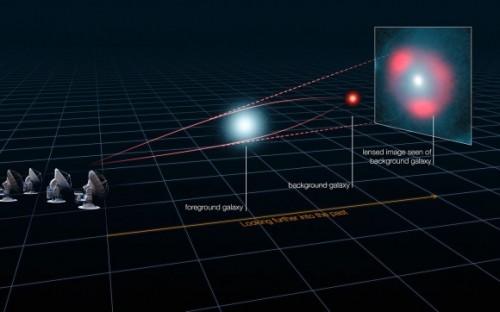This is an example of the most distant use of "gravitational lensing" that we know of, and it demonstrates how a galaxy can amplify the light of an object behind it. The phenomenon was first predicted by Einstein

The Hubble Space Telescope has released this image of a galaxy 9.4 billion light years away. This is an example of the most distant use of "gravitational lensing" that we know of, and it demonstrates how a galaxy can amplify the light of an object behind it. The phenomenon was first predicted by Einstein, and is used to measure mass (including the mass of the mysterious dark matter).
"The galaxy was discovered by chance," says Erin van Dar Wall, from the Max Planck Institute for Astronomy in Heidelberg, Germany.
"I was looking at observations of previous projects and suddenly I noticed a galaxy that looks strange. It appeared to be a very young galaxy, but at a much closer distance than expected. She wasn't even part of our observation program."
The alignment between the galaxy J1000+0221 and the object behind it was so perfect that a ring of light could be seen around it. Scientists previously thought that this type of lens was rarely created. This leaves two possibilities: that the team of astronomers was lucky, or that there are more young galaxies than previously thought.
Other things you might want to read:
"Gravitational lenses are formed as a result of accidental alignment. In our case, the alignment was really accurate," said a press release from the European Space Agency.
To complicate matters further, the magnified object is a dwarf galaxy in which many stars are formed - a relatively light but very young galaxy (10-40 million years old) and producing new stars at an enormous rate. The chance that such a galaxy will be gravitationally compressed and visible to us is small. But still, this is already the second star-forming galaxy discovered by the gravitational lensing method."
"This is an interesting and strange discovery," says van der Wall. "This is a completely serendipitous discovery, but it has the potential to start a new chapter in describing the evolution of galaxies in the early universe."
The study was accepted for publication in the Astrophysical Journal. In the meantime you can find it atArxiv.
Source: The Hubble Space Telescope Information Center on the European Space Agency website

One response
"Predicted for the first time by Einstein" should be written in advance, otherwise it can be interpreted that he actually saw the phenomenon.